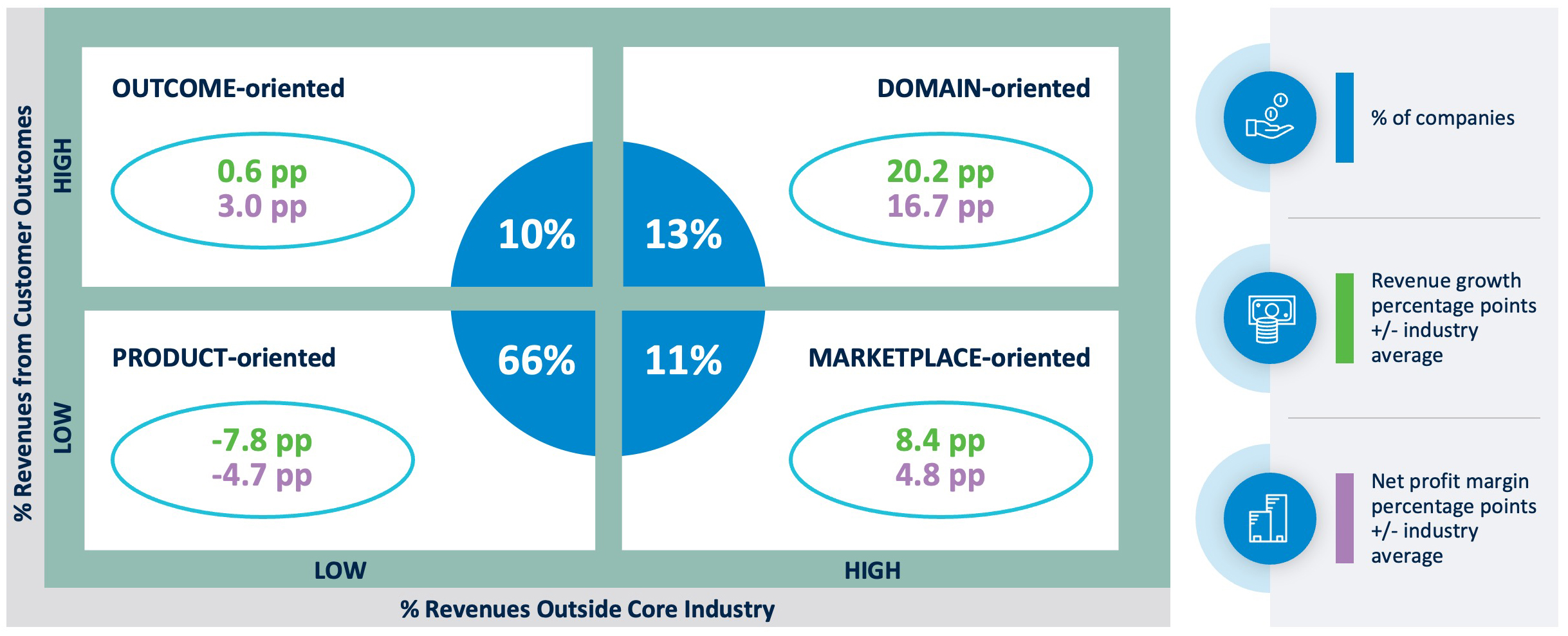What It Takes to Become Domain-Oriented
Some companies are born domain-oriented, like Shopify. Its vision is to support the entire customer need of running an e-commerce business, including building a brand, creating an online presence, setting up a store, selling, marketing, and managing finances. To deliver, Shopify helps customers achieve outcomes such as growth and global expansion by partnering with developers, designers, marketers, warehousers, payment companies, and others. That Shopify has captured 10 percent of US e-commerce market share in just a few years is testimony to the success of taking a domain orientation.[foot]Shopify, Q1 2023 Financial Results webcast presentation, “Leading the Future of Commerce,” May 4, 2023, https://s27.q4cdn.com/572064924/files/doc_presentations/2023/Investor-Overview-Deck-Q1-2023.pdf.[/foot]
But for most companies, becoming domain-oriented will be a journey, often from being product-oriented. And many companies will typically operate in more than one domain, even at a given time. Global building materials company Cemex, for instance, has a very successful product-oriented offering with Cemex Go, an app that is a single point of contact for customers buying cement products. Cemex also runs successful outcome-oriented businesses, like Arkik, a company that offers solutions for managing concrete plants and interactions with builders; and marketplace-oriented businesses, like Construrama, Cemex’s construction and building materials chain for small companies. Cemex is also becoming domain-oriented with Regenera, which provides recycling solutions for building material waste.[foot]Cemex Go, Arkik, and Construrama are described in Woerner, Weill, and Sebastian, Future Ready: The Four Pathways to Capturing Digital Value. Regenera is described at “Regenera—Committed to Circularity,” Cemex S.A.B. de C.V., https://www.cemex.com/products-solutions/regenera.[/foot]
The mindset change needed to become a domain-oriented company is enabled by both management mechanisms and strong technology capabilities. In analyzing our 2022 survey, we found that domain-oriented companies had leading capabilities in four areas, two areas associated with these mechanisms and two with technology capabilities:
Management Mechanisms
- A coach-and-communicate management style. Domain-oriented companies typically operate in real time, and don’t have the time or need for employees to go up and down the hierarchy for approvals and guidance. Instead, senior executives set the vision and guardrails and then empower teams to make it happen.
- Effective use of dashboards. Dashboards make data transparent so that employees throughout the company can monitor performance, including customer outcomes, and can assess when to course-correct.
Technology Capabilities
- A robust and flexible API service layer to support platform reuse. A domain-oriented company connects in real time to the customer’s choice of channel and to the myriad of internal systems and partners that provide identity management, credit assessment, onboarding, customer data (via the CRM), and back-office operations (via the ERP), among others, to process the transactions.
- Technologies for sharing information with partners (e.g., blockchain). Enabling a domain orientation typically requires sharing pre-agreed-upon information with partners in real time so they can help make the customer journey seamless.
Whether your company moves to become domain-oriented is a risk versus return decision. Helping customers achieve their outcomes requires a better understanding of customers’ needs, motivations, and goals, and is a step beyond selling products and services; thus, domain-oriented companies take on more risk. Seamlessly partnering with other companies outside of your core industry while being accountable when customer interactions involving those partners go awry also increases risk. But the returns for domain-oriented companies are stellar. Are you ready to become a domain-oriented company?









